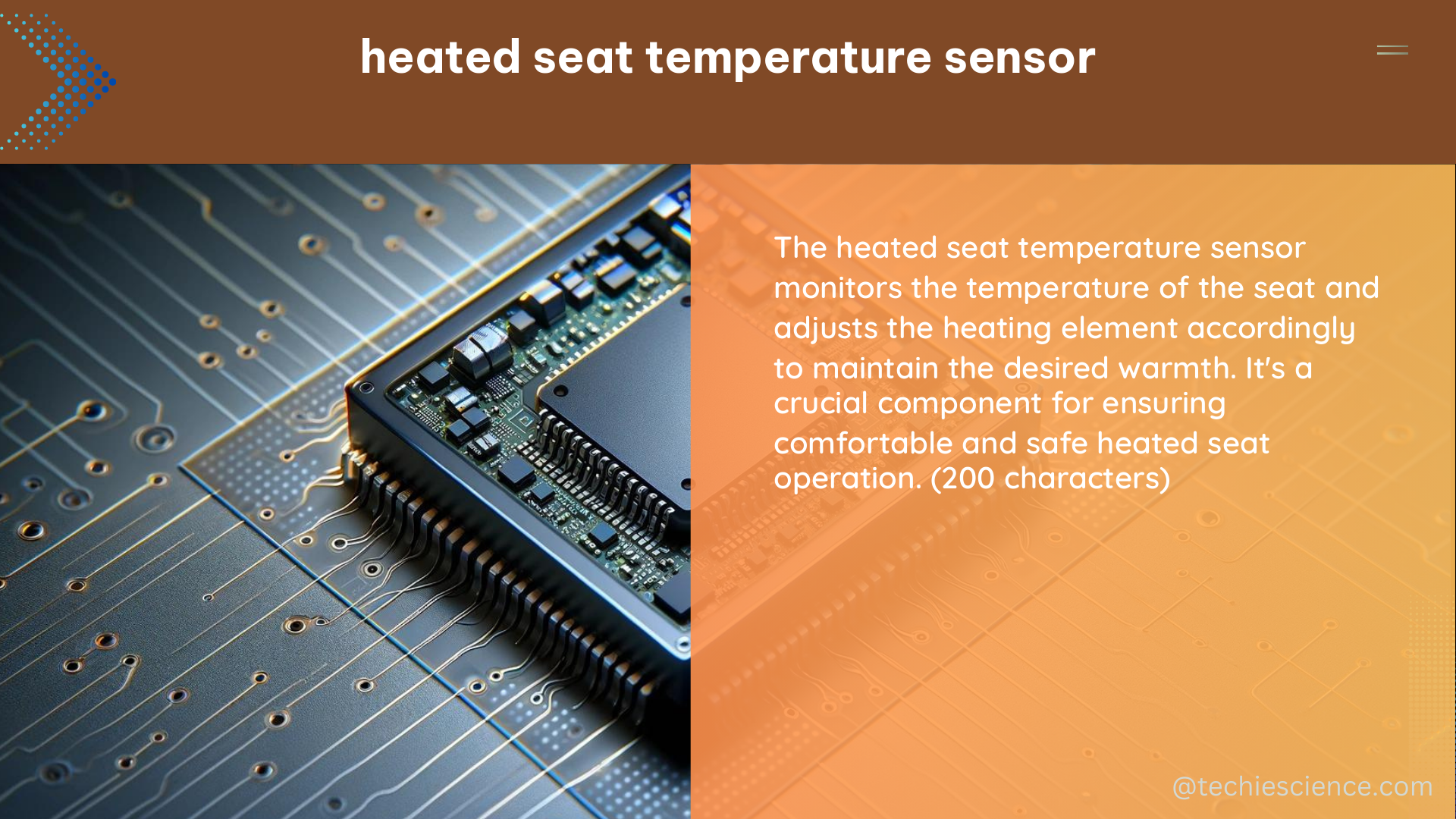The heated seat temperature sensor is a crucial component in the functioning of heated car seats. It is typically a 10kOhm NTC (Negative Temperature Coefficient) thermistor, a type of temperature-sensitive resistor that decreases in resistance as the temperature increases. This sensor is strategically placed within the seat, alongside the heating elements, to provide real-time feedback on the temperature of the seat.
Understanding the Heated Seat Temperature Sensor
Technical Specifications
- Sensor Type: 10kOhm NTC Thermistor
- Resistance Range: 10kOhm at 25°C (77°F), decreasing as temperature increases
- Operating Temperature Range: -40°C to 150°C (-40°F to 302°F)
- Accuracy: ±1% at 25°C (77°F)
- Thermal Time Constant: 10 seconds (typical)
- Dimensions: Approximately 5mm x 3mm x 2mm (0.20″ x 0.12″ x 0.08″)
Sensor Location and Function
The heated seat temperature sensor is located within the seat, typically embedded in the seat cushion or backrest, in close proximity to the heating elements. Its primary function is to monitor the temperature of the seat and provide feedback to the seat control unit, which then adjusts the power supplied to the heating elements to maintain the desired temperature.
Diagnosing Heated Seat Temperature Sensor Issues

Using a Diagnostic Tool
In the case of a BMW Z4, the heated seat temperature sensor can be diagnosed using a tool like Carly, which can be plugged into the vehicle’s OBD (On-Board Diagnostics) port. This tool can reveal any faults in the seat control unit, including issues with the temperature sensor. If the sensor is found to be faulty, it may need to be replaced.
Checking the Wiring
It is also possible that a broken wire to the sensor is causing the issue. To diagnose this, you can check the resistance across the thin wire in the heated seat wiring block, located under the seat. A resistance reading that is significantly different from the expected 10kOhm at room temperature may indicate a wiring problem.
Considering the Interior Temperature Sensor
In some cases, the interior temperature sensor in the dashboard can also affect the functioning of the heated seats. If this sensor is not working correctly, it can cause the car to disable the heating and cooling functions, including the heated seats. A quick scan of the seat control unit can reveal if this is the issue.
Other Factors Affecting Seat Temperature
Heating Element Resistance
The temperature sensor in the seat is not the only factor that affects the temperature of the seat. The resistance of the heating element itself can also play a role. For example, in the Chevy Bolt EV, the resistance of the heating element is a variable resistor, and its resistance changes as the temperature of the seat changes.
Measuring Seat Temperature
To determine the effectiveness of the heating element, you can measure the temperature of the seat using a thermometer probe or a heat gun. This can help identify any issues with the heating system, such as a faulty heating element or a problem with the temperature sensor.
Conclusion
The heated seat temperature sensor is a critical component in the functioning of heated car seats. By understanding its technical specifications, location, and diagnostic procedures, you can effectively troubleshoot and maintain the heated seat system in your vehicle. Remember to always refer to the manufacturer’s recommendations and safety guidelines when working on your car’s electrical systems.
References:
- Heated seat temp sensor.. – Z4-forum.com
- 2011 turbo driver ventilated/heated seat not working – Rennlist
- How To Make Heated Seats Hotter | Page 3 – Chevy Bolt EV Forum

The lambdageeks.com Core SME Team is a group of experienced subject matter experts from diverse scientific and technical fields including Physics, Chemistry, Technology,Electronics & Electrical Engineering, Automotive, Mechanical Engineering. Our team collaborates to create high-quality, well-researched articles on a wide range of science and technology topics for the lambdageeks.com website.
All Our Senior SME are having more than 7 Years of experience in the respective fields . They are either Working Industry Professionals or assocaited With different Universities. Refer Our Authors Page to get to know About our Core SMEs.